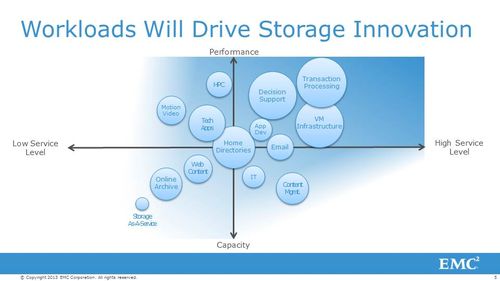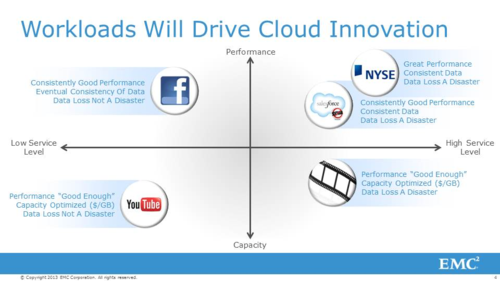In my post last month on Thought Feast, I talked about the struggle organisations seem to be having with Cloud adoption. It was then very timely that, on 10th June, I was at the Forrester event in London talking to CIOs and Senior Architects from some of our customers and saw David Goulden, EMC President and COO, deliver his keynote on Cloud workloads. David called out the fact that, historically, enterprise IT has only really focused on capacity and hasn’t had discussions with the business about performance and SLAs when considering where to host application workloads.
Moving forward, organisations need to consider performance and the desired SLA to correctly determine where to host their workloads – especially when thinking about performance or service levels when using a Public Cloud. This perspective was met by much scribbling in notebooks or tapping on iPads and some photographing of the slides, indicating that David’s message clearly resonated with the audience.
David went on to describe the filters (economics, risk and functionality) that should be used to define the enterprise Cloud strategy and ensure workloads are hosted in the right Cloud environment. Correct application of those filters actually demonstrates that, for many workloads in the typical enterprise, a well-managed Private Cloud is more cost effective than using Public Cloud offerings. This also seemed to strike a chord with the audience, and it was a hot topic of discussion at the dinner EMC hosted with customers that same evening.
 In the current climate of austerity, IT organisations are under pressure to reduce operating costs, and many people have jumped to the conclusion that the use of Public Cloud can save money compared to hosting the workloads themselves. Appropriate analysis is needed to ensure the performance and SLAs meet business needs at a price point that is desirable.
In the current climate of austerity, IT organisations are under pressure to reduce operating costs, and many people have jumped to the conclusion that the use of Public Cloud can save money compared to hosting the workloads themselves. Appropriate analysis is needed to ensure the performance and SLAs meet business needs at a price point that is desirable.
Or, put another way, it is very much a case of “buyer beware” as Cloud service contracts seldom address security, commit to SLAs or have termination rights. All these things need to be factored into the decision-making process.

